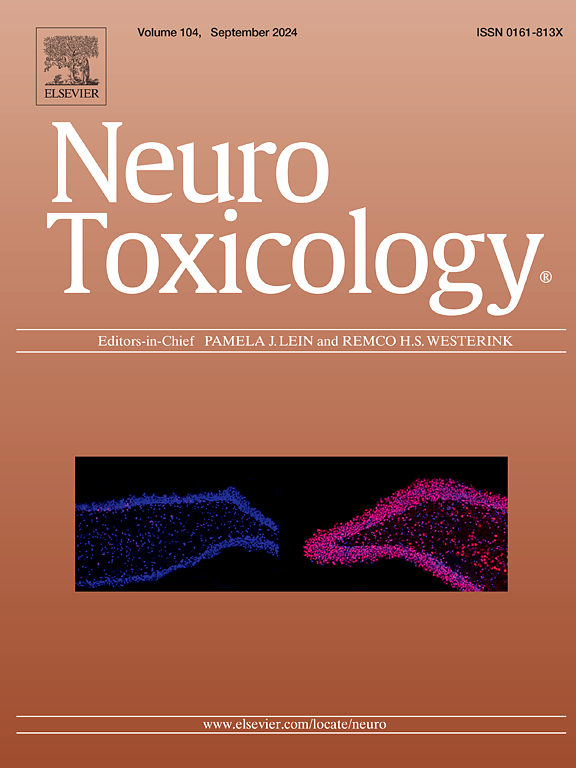异苯并呋喃-1(3H)- 1衍生物对联吡啶除草剂致成年雄性大鼠神经损伤和酶活性失调的保护作用
IF 3.9
3区 医学
Q2 NEUROSCIENCES
引用次数: 0
摘要
Diquat (DQT)是一种广泛应用于农业的联吡啶类除草剂。暴露于DQT可能会使抗氧化系统不堪重负,导致脑、肝和肾等器官的氧化损伤。由于大脑的高耗氧量、相对较低的抗氧化水平和有限的再生能力,它特别容易受到氧化损伤。面对应激因子,使用能够修复和替换氧化生物分子的化合物是维持氧化还原稳态的一个有希望的选择。异苯并呋喃-1 (3H)- 1衍生物(命名为化合物1)被认为是控制DQT诱导的脑氧化还原失衡的潜在候选者。本研究旨在通过体外和体内模型,探讨DQT的神经毒性机制以及化合物1在阿尔茨海默病影响的大脑区域海马和皮层中的抗氧化潜力。化合物1降低DQT引起的海马神经元原代培养细胞内ROS水平和脂质过氧化。此外,化合物1显著提高DQT治疗大鼠大脑GSH水平。化合物1还能降低DQT诱导的脑内脂质过氧化和羰基化蛋白水平。DQT暴露导致海马神经元损伤。化合物1,防止CA1和海马齿状回区域的神经元损伤。我们的研究结果表明,DQT导致海马和皮层的氧化损伤和神经元死亡。此外,化合物1通过减少暴露于DQT引起的氧化损伤而表现出神经保护特性。本文章由计算机程序翻译,如有差异,请以英文原文为准。
Protective role of isobenzofuran-1(3H)-one derivative against neuronal injury and enzyme activity dysregulation induced by bipyridyl herbicide in adult male rats
Diquat (DQT) is a bipyridyl herbicide widely used in agriculture. The exposure to DQT may overwhelm the antioxidant system, leading to oxidative damage in organs such as the brain, liver, and kidneys. The brain is particularly susceptible to oxidative damage because of its high oxygen consumption, relatively low antioxidant levels, and limited regenerative capacity. Faced with stressful agents, using compounds capable of repairing and replacing oxidized biomolecules is a promising option to maintain redox homeostasis. Isobenzofuran-1 (3H)-one derivative (named compound 1) emerges as a potential candidate to control the redox imbalance induced by DQT in the brain. The present study aimed to explore the neurotoxicity mechanisms of DQT and the antioxidant potential of compound 1 within the hippocampus and cortex, brain regions impacted by AD, using in vitro and in vivo models. Treatment with compound 1 reduced intracellular levels of ROS and lipid peroxidation in primary cultures of hippocampal neurons caused by DQT. Moreover, compound 1 significantly elevated GSH levels in the brains of rats subjected to DQT treatment. Treatment with compound 1 also decreased lipid peroxidation and carbonylated protein levels in the brain induced by DQT. The exposure to DQT resulted in neuronal injury in the hippocampus. Compound 1, protected against neuronal damage in CA1 and dentate gyrus hippocampal regions. The findings of our study suggest that DQT leads to oxidative damage and neuronal death in both the hippocampus and the cortex. Furthermore, compound 1 exhibits neuroprotective qualities by reducing oxidative damage caused by exposure to DQT.
求助全文
通过发布文献求助,成功后即可免费获取论文全文。
去求助
来源期刊

Neurotoxicology
医学-毒理学
CiteScore
6.80
自引率
5.90%
发文量
161
审稿时长
70 days
期刊介绍:
NeuroToxicology specializes in publishing the best peer-reviewed original research papers dealing with the effects of toxic substances on the nervous system of humans and experimental animals of all ages. The Journal emphasizes papers dealing with the neurotoxic effects of environmentally significant chemical hazards, manufactured drugs and naturally occurring compounds.
 求助内容:
求助内容: 应助结果提醒方式:
应助结果提醒方式:


